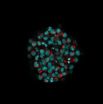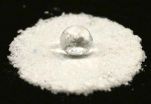(Press-News.org) Go to the DIY-market in the morning, buy the fireplace, and that evening, enjoy the cozy warmth and homey atmosphere of your new ornamental hearth. The suppliers of ethanol fireplaces are doing a brisk business with the lightweight, easy-to-install ornamental stoves with no chimney. However, caution is warranted when operating these fireplaces, because ethanol is a fuel that, together with the air, forms a highly combustible atmospheric mixture. If ethanol runs out when filling the combustion chambers and it ignites, then the entire room could go up in flames.
On top of this, these decorative items conceal another potential risk: If the manufacturers are to be believed, the devices do not discharge any harmful combustible residues into the ambient atmosphere. A study by the Fraunhofer Institute for Wood Research WKI in Braunschweig indicates the opposite. "These stoves do not feature any guided exhaust system whatsoever, so all combustible products are released directly into the environment. Those are, for example, very fine combustion particles and gaseous compounds like formaldehyde and benzene. Hardly any data exists yet about the effect of ethanol stoves on air quality of interior spaces," explains Dr. Michael Wensing, chemist at WKI. The researcher and his colleagues have examined the level and nature of the released emissions. Likewise wood-burning stoves have also been on trial.
Tests in the Test Chamber
The ethanol fireplaces were tested inside a stainless steel, 48 m3 test chamber. In the process, the engineers took the DIN 4734-1 standard into account, defined the technical minimum standard for ethanol fireplaces, and ventilated the test chamber according to manufacturer instructions. Dr. Wensing's team examined four stoves and a total of eight liquid and gelatinous fuels. "In purely theoretical terms, ethanol and bioethanol completely burns up into carbon dioxide (CO2) and water. But under real conditions, things turn out differently. On a case-by-case basis, precisely how the course of that incineration runs really depends on the quality of the fuel and other factors – like the type of fuel, or the incineration temperature. As a rule, ethanol does not burn out completely. Rather, the incineration process results in CO2 – along with poisonous gases (like carbon monoxide, a respiratory toxin), organic compounds (like benzene, a carcinogen), and irritant gases (like nitrogen dioxide and formaldehyde), as well as ultrafine combustion particles," explains Wensing. In the majority of cases, the scientists were able to measure high concentrations of pollutants, and the guideline values were frequently exceeded. For example, all devices exceeded the guideline value for indoor air quality of 0.35 mg/m3 for nitrogen dioxide; in one case, the result was considerable: 2.7 mg/m3. With respect to formaldehyde, the stoves likewise failed to fulfill the requirement of 0.1 ppm (parts per million). Here, the highest value measured equaled 0.45 ppm. One stove reached a peak concentration of released carbon dioxide equal to 6,000 ppm – placing it far above the hygienically acceptable threshold value of 1,000 ppm. The decisive factor here is also the fuel consumption rate. This means that the more ethanol which is burned within a certain period, the greater will be the amount of pollutants released. At the same time, ultrafine combustion particles were released. These have a diameter measuring 10,000 less than the thickness of a human hair – and they can penetrate deep into the human lung. "Ornamental stoves with ethanol-based firing are a source for pollutants in indoor air that are hazardous to one's health. In order to guarantee an air quality level that does not pose a risk to human health, we advise avoiding the use of these devices in the interior of apartments. The units should only be operated in large, very well-ventilated spaces, " states Wensing in summary.
The testing of wood-burning stoves – which have always been popular as an additional heat source – resulted in a quite different picture, based on the testing. In Germany, emissions from this heat source into the outside air are subject to strict regulatory mandates. The stresses placed on inhabited interior spaces – for example, from stove doors with faulty seals – had been neglected until now. For that reason, researchers from WKI studied seven stoves in situ in homes under real-life conditions. Here, the focus was placed on volatile organic compounds, fine and ultrafine particles, and combustion particles like carbon dioxide, carbon monoxide, formaldehyde and nitrogen dioxide. The finding: As long as the stove door is closed, the influence on the air quality within the interior space is negligible. Emissions enter the air of the room only when the fire wood is replenished and ignited. At that point, the researchers were able to measure a brief spike in concentrations. "During closed-door operation, no substances of any noteworthy level were released. For instance, the formaldehyde values were harmless," Wensing explains. There were a few exceptions, though: With one of the ovens, the researchers identified very high concentrations of benzene at 72 micrograms/m3. However, they attribute this rise to the consumption of the paraffinic ignition device. By comparison: When lighting up this oven with paper, the value was only 8 micrograms/m3." As long as the stove door and the ash pan are well-sealed, there is no need to fear any compromise to human health. The ventilation damper should be positioned in such a manner that the stove draws air well, and any paraffinic ignitors should be dispensed with," says Wensing.
INFORMATION: END
Ethanol fireplaces: The underestimated risk
2014-09-03
ELSE PRESS RELEASES FROM THIS DATE:
Fingerprints for freight items
2014-09-03
Thousands of freight items are shipped by plane every day, around seventy percent of them in airliners. Stringent controls are supposed to prevent hazardous substances such as explosives from being smuggled on board. Screening procedures, such as x-ray scanning of freight, are time consuming and costly and have to be repeated in the event of suspicious circumstances. Easily verifiable features that verify that a freight item is "secure" have been lacking until now.
Researchers at the Fraunhofer Institute for Factory Operation and Automation IFF in Magdeburg are working ...
A 'clear' choice for clearing 3-D cell cultures
2014-09-03
VIDEO:
Using a confocal microscope, researchers can study a cleared spherical 3-D tissue culture at any depth. The video begins on the near surface and exits on the far side of...
Click here for more information.
PROVIDENCE, R.I. [Brown University] — Because Brown University biomedical engineering graduate student Molly Boutin needed to study how neural tissues grow from stem cells, she wanted to grow not just a cell culture, but a sphere-shaped one. Cells grow and interact ...
Parrots go to carpentry school
2014-09-03
This news release is available in German.
Scientists from Oxford University, the University of Vienna, and the Max Planck Institute at Seewiesen have shown that a spontaneous innovation by a Goffin's cockatoo can spread to other conspecifics by social learning.
After observing that an adult male Goffin cockatoo named Figaro spontaneously started to sculpt stick tools out of wooden aviary beams and used them for raking in nuts behind grit, the researchers wondered what effect, if any, such an individual technical invention might have on social companions. They used ...
Grooving crystal surfaces repel water
2014-09-03
Researchers from Kyoto University in Japan have developed a novel way to waterproof new functionalized materials involved in gas storage and separation by adding exterior surface grooves. Their study, published in the journal Angewandte Chemie, provides a blueprint for researchers to build similar materials involved in industrial applications, such as high performance gas separation and energy storage.
The materials, also known as porous coordination polymers (PCPs), are hollow nanoscale cage-like structures with the ability to house molecules within their empty ...
New discovery could help turn antibiotic into antimalarial drug
2014-09-03
Melbourne researchers are making progress towards new antimalarial drugs, after revealing how an antibiotic called emetine blocks the molecular machinery that produces the proteins required for malaria parasite survival.
Although emetine is effective against malaria it is not used as a preventive drug due to its significant side effects. However, the work of Walter and Eliza Hall Institute researchers Dr Wilson Wong, Dr Jake Baum and colleagues in showing how emetine attaches to and blocks the molecular machinery that makes the proteins required for malaria parasite survival ...
Sensory reinnervation of muscle spindles after TN defect repaired by autologous vein graft
2014-09-03
After complete transection of a nerve, good neuroanastomosis is needed to prevent the formation of fibrous connective tissues that form obstacles to nerve regeneration, and to facilitate repair of the injured nerve and reinnervation of its original targets. Peripheral nerve defects of more than 10 mm are commonly treated in clinics, and in these injuries a conduit is needed to bridge the gap, prevent the formation of obstacles to nerve regeneration, and guide axonal regrowth. Autogenous vein grafts have been used extensively for the repair of nerve defects in rats. Motor ...
Puerarin accelerates neural regeneration after sciatic nerve injury
2014-09-03
Puerarin is a natural isoflavone isolated from plants of the genus Pueraria and functions as a protector against cerebral ischemia. Can puerarin be involved in the repair of peripheral nerve injuries? Minfei Wu and co-workers from the Second Hospital of Jilin University in China verified that puerarin exerts an ongoing role to activate growth-associated protein 43 in the corresponding segment of the spinal cord after sciatic nerve injury, thus contributing to neural regeneration after sciatic nerve injuries. Their relevant study has been reported in the Neural Regeneration ...
Researchers demonstrate direct brain-to-brain communication in human subjects
2014-09-03
BOSTON –In a first-of-its-kind study, an international team of neuroscientists and robotics engineers have demonstrated the viability of direct brain-to-brain communication in humans. Recently published in PLOS ONE the highly novel findings describe the successful transmission of information via the internet between the intact scalps of two human subjects – located 5,000 miles apart.
"We wanted to find out if one could communicate directly between two people by reading out the brain activity from one person and injecting brain activity into the second person, and do ...
Wind energy cuts the electricity bill
2014-09-03
This news release is available in Spanish.
The UPV/EHU study analyses the electricity market in Spain during the 2008-2012 period -a time of maximum renewable penetration in Spain when energy production within the Special Scheme saw a 57% increase- and quantifies its cost.
To do this, they firstly measured the market savings produced by participating in renewable sources, and secondly, they calculated the amount paid in the form of incentives to green energy. The difference between the two figures represents the net cost of renewable energy. In contrast to other ...
Mouse studies advance treatment for common eye diseases
2014-09-03
Working with mice, a multicenter team of researchers has found a new way to reduce the abnormal blood vessel growth and leakage in the eye that accompany some eye diseases. The finding could lead to the development of new drugs for wet macular degeneration and diabetic macular edema.
The team reports their findings in the Sept. 2 issue of The Journal of Clinical Investigation.
The current standard of clinical care for wet macular degeneration and diabetic macular edema is repeated injections into the eye of antibodies against a protein called VEGF. Each injection costs ...







